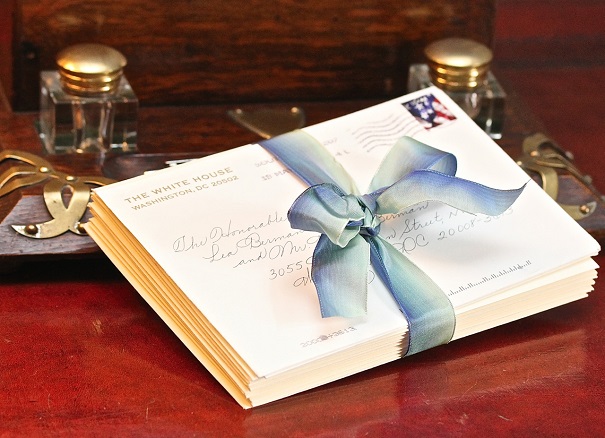Several people have asked about the proper way to address envelopes for invitations and announcements. It’s not so much that the style of addressing an envelope has changed, but more that we’ve changed in how we like to be addressed. This sounds like a boring subject, but addressing an envelope is boring. Personally, I like to have fun with it. When my girls were away at school, I used to write the names of odd characters from the Jeeves and Wooster books on the return address labels. Then the messages from the mailroom about their packages would say things like, “You have a package from Stilton Cheesewright.” Or the mailroom clerk would yell, as my daughter breezed by, “You got something from Barmy Fotheringay-Phipps!” You can imagine how that name was butchered. And it’s always fun to use childhood nicknames when addressing letters, especially if the name is something embarrassing like “Stinky” or “Floppy.” Ah, we social secretaries have to find these little ways to spice up our lives… 
But, seriously, the basic rule is simple: address a person as they would like to be addressed. Many years ago, when I was newly married and had decided to keep my own last name, I introduced myself as “Lea Rogers” to an older gentleman at a party. He made a great point of saying, “You mean, Lea Berman, don’t you?” Clearly he didn’t approve of me using my own name and wanted me to know it. (And I’m still annoyed about it thirty years later – which proves my point.) Eventually I did change my name, not as a political statement, but because I could never remember what name I’d used when dropping off the dry cleaning. It’s respectful to address a person by the name they use themselves.
A few more tips before dropping an invitation in the mail:
1. When a woman keeps her last name after marrying, the invitation should be addressed to: Ms. Jane Doe and Mr. John Smith. The woman’s name should come first. Some people don’t mind being referred to by their husbands’ names, and others really resent it, so the safest thing to do is use the name they use themselves.
2. Blended families: it’s not uncommon for two families to become one, through divorce and remarriage. In that case, an invitation should be addressed this way:
The Smith and Johnson Families Street Address City, State, Zip code
3. Widows should be addressed by their own names, not by the name of their deceased husbands. It’s positively Victorian to go on using the name of a person who no longer exists, rather than a woman’s actual name.
4. If a couple is living together but not married, each name should be written on a separate line:
Ms. Jane Doe Mr. John Smith Street Address City, State, Zip code
5. The same applies for gay couples. They should be invited on one invitation, with the names listed alphabetically on separate lines.
6. For people who hold academic doctorates, it’s appropriate to use the “Dr.” title before their name. They may not use the salutation themselves, but it’s polite to use it anyway.
7. In Washington, there is rampant use of the “The Honorable” before a name. Anyone who has been at a certain level of government service has the right to use the Honorable title while they are in their government jobs. However, only career ambassadors retain the Ambassador title after they’ve left their positions. No one here seems to know this (or they prefer to ignore it), so every other person in Washington DC is styled an “Honorable.” Given the state of the government today, that may be least of our worries.




6 Comments